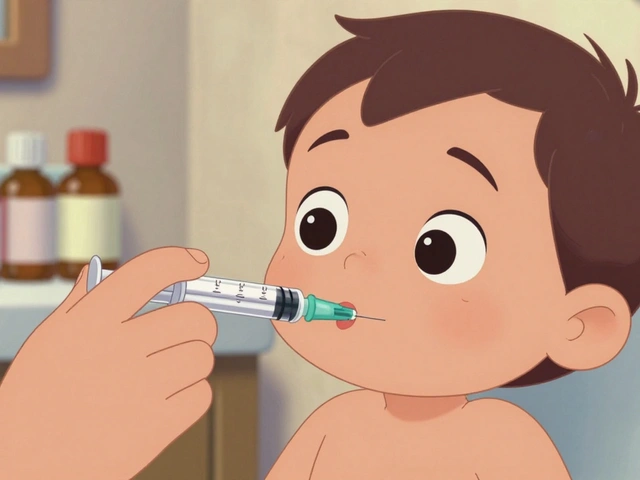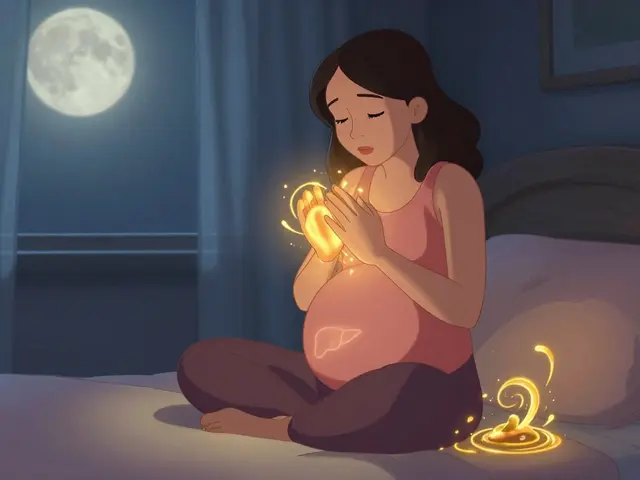Aspirin Safety Assessment Tool
Assess Your Aspirin Safety
This tool helps you understand if aspirin may be safe for your specific medical situation based on factors discussed in the article. Remember: Always consult your doctor before making any medication changes.
Answer These Questions
Key Takeaways
- Aspirin blocks platelet‑activating chemicals, reducing clot formation in many cardiovascular conditions.
- It can be helpful for some clotting disorders but dangerous for others, especially those prone to bleeding.
- Low‑dose (81 mg) aspirin is common; higher doses increase stomach irritation and bleeding risk.
- Always discuss personal history, other meds, and lab results with your doctor before starting or stopping aspirin.
- Alternatives such as clopidogrel or warfarin may be better depending on the specific disorder.
When you hear the word aspirin, you probably think of a cheap pain reliever. In reality, it’s also a powerful antiplatelet drug that can tip the balance of your blood’s clotting system. For patients living with clotting disorders, knowing exactly how aspirin works, when it helps, and when it hurts is critical.
Aspirin is a salicylate medication that irreversibly inhibits the enzyme cyclooxygenase‑1 (COX‑1) in platelets, blocking the production of thromboxane A2 - a molecule that tells platelets to stick together. By silencing this signal, aspirin reduces the chance that a platelet plug will turn into a full‑blown clot. The effect lasts for the lifespan of the platelet (about 7‑10 days), which is why even a single low dose can have lasting antithrombotic impact.
How Aspirin Interferes with Blood Clotting
Platelets are tiny cell fragments that zip to the site of a vessel injury. Once there, they release chemicals that attract more platelets, forming a plug. The key chemical is thromboxane A2, produced by the enzyme cyclooxygenase‑1 (COX‑1). Cyclooxygenase‑1 an enzyme inside platelets that converts arachidonic acid into prostaglandins and thromboxane A2 is the target of aspirin.
When aspirin acetylates COX‑1, the enzyme can’t make thromboxane A2. Without this “sticky” signal, platelets don’t aggregate as readily, and the clot‑forming cascade is slowed. This is why doctors prescribe aspirin to prevent heart attacks, strokes, and certain types of peripheral artery disease.
Blood Clotting Disorders That Interact With Aspirin
Not all clotting problems are created equal. Some involve too much clotting (hypercoagulable states); others involve too little clotting (bleeding disorders). Below are the most common conditions patients ask about.
- Deep vein thrombosis a clot that forms in the deep veins of the legs, often leading to swelling, pain, and risk of pulmonary embolism
- Atrial fibrillation an irregular heart rhythm that increases the chance of clots forming in the atria and traveling to the brain
- Hemophilia a hereditary bleeding disorder where clotting factors VIII or IX are deficient, leading to excessive bleeding
If you live with any of these, the role of aspirin changes dramatically.

When Aspirin Helps: Evidence‑Based Uses
Guidelines from the American Heart Association and Australian Cardiovascular Alliance agree on a few clear scenarios where low‑dose aspirin (usually 75‑100 mg daily) is beneficial:
- Secondary prevention after a heart attack or ischemic stroke - the goal is to stop new clots from forming.
- Patients with confirmed coronary artery disease who have not had major bleeding episodes.
- Selected high‑risk patients with peripheral arterial disease.
In these cases, aspirin’s antiplatelet action reduces the risk of another cardiovascular event by roughly 20 % compared with no therapy, according to meta‑analyses of large trials.
Risks and Red Flags for Patients with Clotting Issues
For people with bleeding‑prone disorders like hemophilia, or those on anticoagulants, adding aspirin can push the balance toward dangerous bleeding. The most common adverse effects include:
- Gastrointestinal irritation or ulceration - especially at doses >325 mg.
- Increased bruising and nosebleeds.
- Intracranial hemorrhage, a rare but life‑threatening event.
If you notice black or tarry stools, persistent stomach pain, or unexplained bruises, stop aspirin and seek medical help immediately.
Dosage Guidelines and Practical Tips
Most patients who benefit from aspirin take a low‑dose “baby aspirin” (81 mg) once daily. Higher doses (325‑500 mg) are sometimes used for acute pain or fever but carry a higher bleeding risk.
Key practical points:
- Take aspirin with food or a glass of milk to protect the stomach lining.
- If you’re over 70 or have a history of ulcers, ask your doctor about a proton‑pump inhibitor (e.g., omeprazole) to reduce stomach damage.
- Never stop aspirin abruptly without consulting your physician, especially after a heart attack.
- Blood tests such as platelet count and bleeding time can help your doctor tailor the dose.

Alternatives and When to Switch
When aspirin isn’t suitable, other antithrombotic agents may be safer.
| Drug | Primary Action | Typical Dose | Key Advantage | Major Risk |
|---|---|---|---|---|
| Aspirin | Irreversible COX‑1 inhibition → ↓ thromboxane A2 | 81 mg daily (low dose) | Cheap, widely available | GI bleeding, ulceration |
| Clopidogrel | P2Y12 receptor blocker → ↓ platelet aggregation | 75 mg daily | Effective in aspirin‑intolerant patients | Bleeding, rare neutropenia |
| Warfarin | Vitamin K antagonist → ↓ clotting factor synthesis | 2‑5 mg daily (INR‑guided) | Strong anticoagulation for atrial fibrillation | Intracranial bleed, requires monitoring |
Clopidogrel is often chosen for patients with aspirin‑induced ulcers, while warfarin (or newer direct oral anticoagulants) is preferred when clotting factors, not platelets, drive the disease - such as in atrial fibrillation.
Checklist for Talking to Your Doctor
- List all current medications, including over‑the‑counter supplements.
- Provide a brief history of any bleeding events or ulcers.
- Ask about the need for blood‑test monitoring (e.g., platelet count, INR).
- Clarify whether you need a low‑dose aspirin regimen or an alternative.
- Discuss lifestyle steps that can reduce clot risk (exercise, quitting smoking, controlling blood pressure).
Having this information ready makes the appointment more efficient and ensures you leave with a clear, personalized plan.
Frequently Asked Questions
Can I take aspirin if I have a history of stomach ulcers?
Usually not without protection. Your doctor may prescribe a proton‑pump inhibitor alongside a low‑dose aspirin, or suggest a different antiplatelet like clopidogrel.
Is daily aspirin safe for people over 70?
Evidence is mixed. For primary prevention, many guidelines now recommend against routine aspirin in seniors without a strong cardiovascular history because the bleeding risk outweighs benefit.
How long does aspirin’s effect last after I stop taking it?
Since aspirin permanently disables COX‑1 in each platelet, the antiplatelet effect persists until new platelets replace the old ones-roughly 7‑10 days.
Should I take aspirin if I’m already on warfarin for atrial fibrillation?
Combining the two dramatically raises bleeding risk. Only a specialist should consider a combined regimen, and usually only for very high clot‑risk patients.
What symptoms indicate a serious bleed while on aspirin?
Black or tarry stools, vomiting blood, sudden severe headache, or unexplained bruising should prompt immediate medical attention.







Aspirin's irreversible COX‑1 inhibition means each platelet stays altered for its entire lifespan, typically seven to ten days; therefore, even a single low dose can exert a lasting antiplatelet effect, which is why clinicians monitor platelet turnover when adjusting therapy. The guide correctly notes that low‑dose (81 mg) regimens are most commonly employed for secondary prevention, because higher doses disproportionately raise gastrointestinal bleeding risk. Patients with a documented history of peptic ulcer disease should be co‑prescribed a proton‑pump inhibitor, or alternatively switched to a non‑acid‑suppressive antiplatelet such as clopidogrel. When evaluating clotting disorders, a thorough review of concurrent anticoagulants-warfarin, direct oral anticoagulants, or heparin-must precede any aspirin initiation. Laboratory markers, including platelet count and bleeding time, can help personalize dosage and anticipate adverse events. Finally, abrupt discontinuation of aspirin without medical guidance can provoke a rebound hypercoagulable state, particularly after recent myocardial infarction.
The article offers a clear overview of aspirin's mechanism, emphasizing COX‑1 inhibition and reduced thromboxane A2 production. It correctly distinguishes between hypercoagulable and bleeding‑prone conditions, which is essential for patient counseling. The dosage chart aligns with current guidelines, noting that 81 mg daily is standard for most secondary‑prevention scenarios. Readers should also appreciate the warning about concomitant use with anticoagulants, as the combined bleeding risk can be substantial. Overall, the piece serves as a solid reference for both clinicians and patients.
Wow, this guide is super helpful!! 🥳 It breaks down the science so you can actually get why aspirin stops clots, and that's defnitely useful for anyone with a bleed disorder. Just remember to talk to your doc before making any changes – they’ll check your labs and thier med history.
Stop ignoring the bleeding risks! Aspirin may be cheap, but when you have a hemophilia background it becomes a danger zone, and the guide rightly flags intracranial hemorrhage as a red alert. If your doctor hasn't ordered a PPI or considered clopidogrel, demand a revision of the plan now. The cost savings are irrelevant if you end up in the ER with a severe bleed.
From a pathophysiological standpoint, aspirin's acetylation of the serine residue in the active site of cyclooxygenase‑1 constitutes an irreversible enzymatic modification that culminates in the suppression of prostaglandin H2 conversion to thromboxane A2, thereby attenuating platelet aggregation cascades. This biochemical interruption possesses a half‑life commensurate with the lifespan of circulating anucleate platelets, a temporal parameter that underpins the clinical rationale for low‑dose regimens in secondary prophylaxis. Moreover, the pharmacodynamic profile of aspirin is distinctly dose‑dependent; sub‑therapeutic dosing (<30 mg) may insufficiently inhibit thromboxane synthesis, whereas supra‑therapeutic dosing (>325 mg) escalates mucosal assault on gastric epithelium via prostaglandin E2 depletion. In patients harboring inherited coagulopathies such as hemophilia A or B, the concomitant reduction in thromboxane‑mediated platelet plug formation synergizes with factor VIII or IX deficiencies, precipitating a hemostatic vulnerability that supersedes any marginal antithrombotic benefit. Conversely, in hypercoagulable states like antiphospholipid syndrome, the antiplatelet action of aspirin can complement anticoagulant therapies by targeting the platelet component of the thrombotic milieu. The guide's recommendation for adjunctive proton‑pump inhibitor prophylaxis aligns with consensus statements from gastroenterological societies, which advocate acid suppression when chronic aspirin exposure exceeds 75 mg daily in at‑risk cohorts. Furthermore, the algorithmic inclusion of platelet function assays, such as VerifyNow or light transmission aggregometry, provides a quantifiable metric to tailor therapy, especially in patients with variable responsiveness due to genetic polymorphisms of CYP2C9. It is noteworthy that the interplay between aspirin and newer oral anticoagulants (direct factor Xa inhibitors or direct thrombin inhibitors) remains an evolving domain, with emerging data suggesting additive bleeding risk without a commensurate reduction in thrombotic events. Clinical decision‑making, therefore, necessitates a nuanced appraisal of individual patient risk stratification models, incorporating CHA₂DS₂‑VASc scores, HAS‑BLED indices, and prior gastrointestinal bleeding episodes. The tabular comparison of antithrombotic agents furnishes a concise yet comprehensive appraisal of pharmacodynamic versus pharmacokinetic considerations, facilitating personalized medicine approaches. In practice, shared decision‑making dialogues that elucidate the mechanistic rationale behind aspirin’s utility-or contraindication-empower patients to adhere to regimens that balance efficacy with safety. Ultimately, the guide succeeds in translating intricate biochemical pathways into actionable clinical guidance, thereby bridging the translational gap between bench research and bedside application. Physicians should also monitor renal function when prescribing aspirin concomitantly with nephrotoxic agents, as impaired clearance can exacerbate systemic exposure. Regular assessment of hemoglobin and hematocrit can detect occult blood loss before overt anemia manifests. Patient education materials that illustrate warning signs-such as melena, hematemesis, or unexplained bruising-have been shown to reduce delayed presentation to emergency services. Finally, longitudinal cohort studies continue to refine the risk‑benefit calculus, indicating that in cohorts over 70 years without prior cardiovascular events, the net clinical benefit may be neutral or negative. Therefore, clinicians must remain vigilant, revisiting the indication for aspirin at each follow‑up encounter to ensure that therapy remains justified.
This piece does a solid job of laying out when aspirin makes sense and when it doesn’t. The checklist for doctor visits is a nice practical touch that many patients overlook. I appreciate the reminder about taking aspirin with food to spare the stomach. Overall, a balanced overview without sensationalizing the risks.
Enough with the half‑hearted advice! If you’re living with a bleeding disorder, tossing a baby aspirin into your routine without a specialist’s sign‑off is sheer negligence. The guide mentions the red flags, but the urgency of acting on them should be shouted from the rooftops. Patients deserve crystal‑clear directives-not vague “talk to your doctor” admonitions. This is a matter of life‑or‑death, not a casual health tip.
Think of aspirin as a double‑edged sword ⚔️-it can shield your heart but also tip the scales toward bleeding. The guide’s comparison chart helps you weigh those edges, especially when considering alternatives like clopidogrel. Remember, every body’s response is unique; what works for one may harm another. Keep an open dialogue with your healthcare team, and don’t shy away from asking for a platelet function test if you feel unsure. 🌟
Great summary, very easy to follow! 😊
Loved the guide! It breaks down the science and gives real tips 🙌 Keep the info coming
The narrative captures the gravity of bleeding risks, yet the tone feels a bit distant. I wish there were more personal anecdotes to illustrate the stakes. Still, the checklist is a useful tool for patients navigating complex therapy decisions. The emphasis on monitoring labs resonates with my own experience. In the end, the guide walks the fine line between information and alarm.
Thank you for such a thorough guide! 🌼 It balances technical details with patient‑friendly advice, which is exactly what many of us need. The section on when to stop aspirin and watch for warning signs is especially helpful. I’ll definitely share this with my support group, and we’ll discuss the checklist at our next meeting. Keep up the good work!
Adding to Joe’s point, it’s also worth noting that aspirin’s effect on platelet function can be monitored with serum thromboxane B₂ levels, which some labs offer as a surrogate marker. This can be particularly useful in patients who have had prior gastrointestinal bleeds and need a tailored dose. If you’re considering switching to clopidogrel, remember that the loading dose is 300 mg followed by 75 mg daily, and platelet inhibition may take a few days to stabilize.